March 18th, 2014 § § permalink
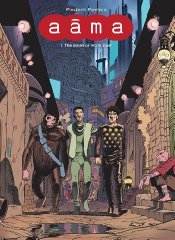
The first volume of Frederik Peeters’ ongoing far-future science fiction epic, Aama. It came out in English last fall in the UK. It’s out now in the U.S. You can get it.
Jonathan of Page 45 calls it:
Pure science fiction heaven. I now see exactly why this won the prestigious Best Series of 2013 prize at Angoulême. As utterly bizarre and charming in its own way as perhaps the greatest science fiction graphic novel ever THE INCAL, yet without the existential farcicality and turbo paced freneticism of that particular classic, it won me over instantly. Possibly the highest personal praise I can pro-offer is it greatly minded me of Iain M. Banks prose, in the sense that we are presented with a highly complex and well developed universe and cast of characters, but there is a real sense of mystery to the plot which immediately draws you in. The art also, has a lightness of touch yet richness of detail which engendered a sense of real wonderment in me. Suspension of disbelief complete, this was a joyful thirty minutes reading indeed. For someone who likes his fiction with a futuristic twist, this is as close to nirvana as it gets.
Fans of Frederick, who’ve already read the autobiographical BLUE PILLS, the enigmatic ‘Tales of the Unexpected’-esque SANDCASTLE and the equally surreal PACHYDERME, will already know of his ability to craft and illustrate stories with an almost cinematic sense of pacing and scope, to display genuine emotional depth in characters both lovable and loath-worthy alike. This is probably his most complete and indeed accessible work for me, despite the genre which will probably limit its appeal to some people, although it really shouldn’t. I am pleased the jurors of Angoulême and just European readers of bande dessinee in general, are able to appreciate greatness irrespective of its flavour. I am delighted also to report this is merely volume one in what I hope to be a long running epic.
March 14th, 2014 § § permalink

Jean Ferry’s The Conductor and Other Tales is one of five finalists for the 2013 French-American Foundation Translation Prize! Congratulations to my fellow nominees: Adriana Hunter, Mike Mitchell, Jordan Stump, and Chris Turner for fiction, and Malcolm DeBevoise, Alison Dundy, Nicholas Elliot, Michael Holland, Janet Lloyd, and Thomas Scott-Railton for non-fiction! All my thanks to jury members Linda Asher, David Bellos, Linda Coverdale, Emmanuelle Ertel, and Lorin Stein. And most of all, to my publisher Wakefield Press!
March 13th, 2014 § § permalink
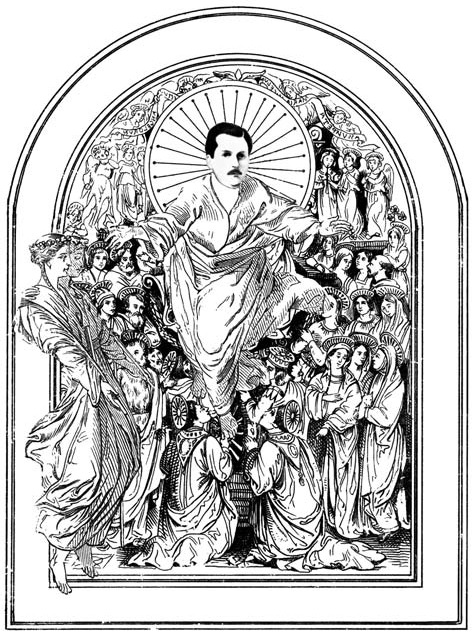
- At Necessary Fiction, in their Translation Notes series, a piece I wrote tracing the many challenges posed by a single very short story from Jean Ferry’s The Conductor and Other Tales, on his hero Raymond Roussel’s ascension to heaven (see above).
- At Comic Book Resources, in an article by T.J. Dietsch, a recent interview I translated with Hub, on the occasion of his comic Okko: The Cycle of Fire being released in the U.S. by Archaia.
- A translation for The New York Times from January: former Le Monde correspondent Sylvain Cypel’s thoughts on comedian Dieudonné and the larger spectre of European racism in “Deciphering the Quenelle.â€
- Josh Coblentz reviews Jean Ferry’s The Conductor and Other Tales for HTML Giant:
[T]he ultimate sensation one gets after reading this work, Ferry’s only collection of fiction, is that he’s not so easily lumped in with the surrealist or pataphysic movements that attempted to swallow him into their pigeonholes. Instead, as translator Edward Gauvin states in his introduction, “Ferry is the exception to every movement he’s been in,†a claim that ironically puts him further in line with the ideals of pataphysics …
This small yet potent collection has too much to discuss in one brief review… For fans of quirky, bleak, and short French fiction from the post-surrealist era, this book is a new must have.
March 10th, 2014 § § permalink
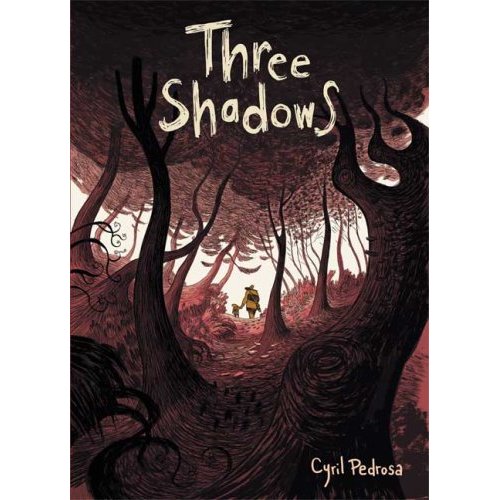
Sometimes there’s a review that’s all the more in-depth for coming from outside the traditional media outlets. The educational outreach site Reading With Pictures was
founded in 2009 by award-winning graphic novelist and nationally syndicated cartoonist Josh Elder in order to revolutionize the role of comics in education…
At Reading With Pictures, we believe that comics have the potential to be more engaging, more efficient and more effective educational tools than traditional classroom materials.
A different, and in this case, lovingly detailed look at a book you’ve worked on is wonderful. Adrian Neibauer analyzes Cyril Pedrosa’s award-winning 2008 graphic novel Three Shadows, from FirstSecond:
I would highly recommend this book for any high-school literature classroom. Certain sections can also be used in the middle grades (6-8) for discussing the graphic novel’s major theme of fate. However, due to some mild language and non-sexualized nudity, THREE SHADOWS is best kept in high-school literature courses.
Neibauer divides his review into discussions of “Story” and “Art,” but does not neglect to mention in his first line that the comic is translated. Now how can we get translation as an aspect of comics into schools?
Here are some highlights:
STORY REVIEW
THREE SHADOWS by Cyril Pedrosa and translated from French by Edward Gauvin is the saddest and most moving graphic novels I have ever read. Louis and Lise are a husband and wife who are raising their young son, Joachim, in an unnamed rural, European landscape. Their small family is filled with simple pleasures and lots of love as they work together on their farm. However, everything changes when three mysterious shadows appear on the horizon haunting the family. Never explicitly stated at first, we learn later that the shadows beckon for the young Joachim. Joachim’s father, Louis, flees with Joachim in a brave, yet foolish attempt to outrun his son’s fate: death.
Throughout the story, we learn just how far a parent would go to protect their child. Embedded within this story are deep and complex discussions about fate, life, and death; as well as plenty of opportunities for older readers to practice the skills of making inferences and predictions.
ART REVIEW
THREE SHADOWS is completely pencil-drawn. Pedrosa’s use of black and white charcoal prepares the reader for the dark tone of the story. Pedrosa is a former Disney artist/animator and this experience serves him well here. He writes little dialogue, yet conveys much action, movement, and emotion. he characters seem to animate themselves as you turn each page.
Pedrosa’s artwork forces the reader to stop and think. His attention to detail gives readers all the clues they need to make accurate predictions and to infer about the plot. Each page can be used as a talking point or a stand-alone example of the novel’s themes and symbols.
March 8th, 2014 § § permalink
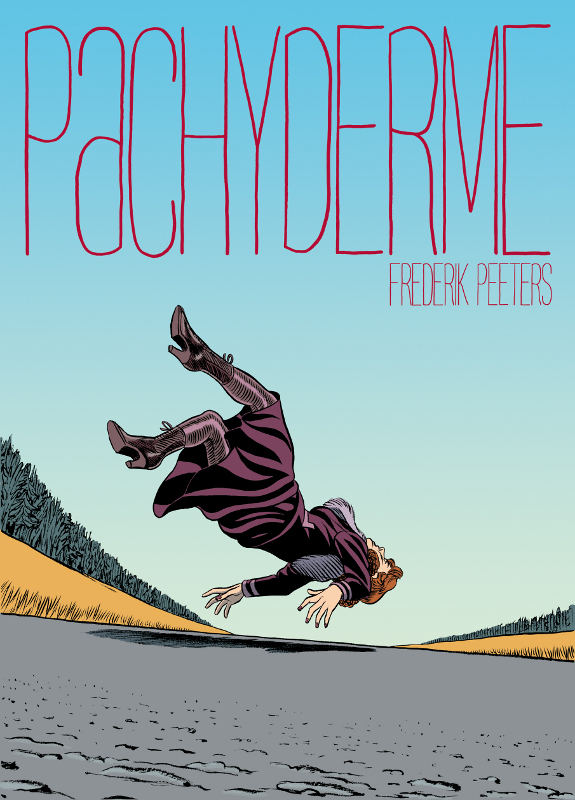
RevN4 says:
This is book that begs multiple read-throughs. This is a piece of literature that needs to be discussed among friends. Peeters’ script and artwork communicates a dream-like state that simultaneously doesn’t and does make perfect sense. He has captured a dream in the form of a comic…
Readers who enjoy both literature and comics in the spirit of City of Glass and Ghost World will find much to enjoy in Pachyderme.
March 6th, 2014 § § permalink
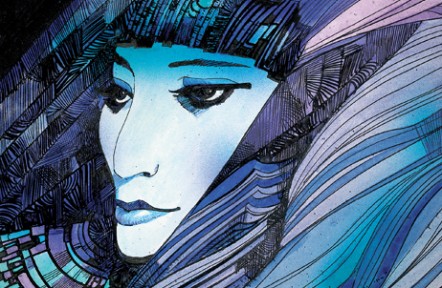
At The Comixverse, Zedric Dimalanta calls the Sergio Toppi’s work “absolutely astounding” in Sharaz-De: Tales from the Arabian Nights, published in 2012 by Archaia:
A rare English translation of a seminal work by one of Europe’s most influential artists.
Features absolutely gorgeous line art and radical storytelling techniques that any serious student of comics and sequential art with the means should view and study.
Classic tales are allowed to retain their simple charm.
Informative, entertaining foreword by Walt Simonson is almost a brief art lesson on its own.
March 4th, 2014 § § permalink
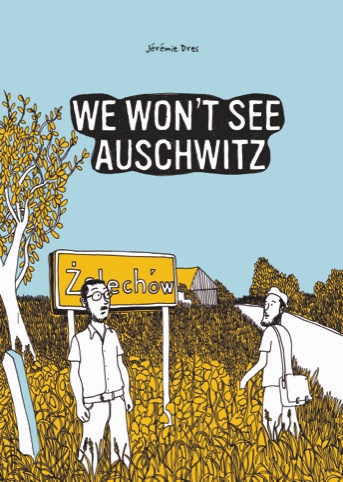
Jérémie Dres, a French comics creator of Jewish Polish descent, recently gave an event about his graphic novel We Won’t See Auschwitz, published last year by SelfMadeHero. Late Night Library features an interview with the creator (scroll down):
Stephanie Trott at Cleaver Magazine (where Brazos Price also reviewed Frederik Peeters’ Pachyderme from the same publisher) says:
The reader is dropped immediately into the action, rendezvousing with Dres in Warsaw’s historic Old Town as he searches for his grandmother’s original home on an unseasonably warm June afternoon. Together we search with him through the clouded eyes of the past for the buildings and neighborhoods his grandmother once recalled perfectly from memory, only to find that they either no longer exist or have been altered beyond recognition. Dres, eager to learn from those currently dwelling within the city walls, next meets two “young, Jewish, Polish, and hip†Varsovians who advise and answer his questions about the current sentiments of Poland toward Jews. He is amazed to find that there are still Jews in Poland, his own family having long since departed for France. Dres continues to meet both older and younger Polish residents, conducting a series of informational interviews and receiving in return detailed contemporary history lessons. The week becomes one where movement is somewhat determined by conversation, the destinations lingering on the horizon like doors begging to be opened. We tumble into this rabbit-hole expedition like Alice through the looking glass, as the present becomes a vehicle for gaining access to the past.
At Library Journal, Ingrid Bohnenkamp of Missouri’s Springfield-Greene County Library District says:
By not seeing Auschwitz, Dres discovers family secrets and an understanding of where he came from, but, more important, he discovers the vibrant Jewish identity that existed before and during the Nazi occupation and that continues in modern-day Poland.
Verdict: For readers who think a serious story can’t be told with pictures, Dres offers a wonderful introduction to the graphic novel. Recommended for graphic novels fans who want to read more nonfiction.
And finally Publishers Weekly weighs in:
The book, an English translation of Dres’s Italian graphic novel of the same name, details the author’s journey to Poland with his brother, Martin, to trace their Jewish roots after the death of their grandmother. Told in a clean journalistic style that prizes accuracy over adventure… The book gets off to a promising start, describing the humorous and touching relationship between Dres and his grandmother. It then delves meticulously into the brothers’ journey to Poland and the surprises they find there regarding their Jewish heritage. As the title suggests, the brothers choose not to visit Auschwitz and instead focus on the current state of Jews and Judaism in modern-day Poland. It’s a smart decision to avoid this already-well-trodden territory… Simple, pared-down b&w visuals are a good match for the subject matter, and the more active and emotionally resonant scenes, like the one describing the discovery of the grave sites of the brothers’ ancestors.






